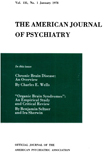Abstract
There are a number of selective factors which have operated in determining the group character of the army delinquents with which the present investigation deals. Some of these selective factors have been mentioned; others are easily inferred. Within the limits of the group studied, the following conclusions are drawn:
1. The majority of army delinquents were delinquent prior to entering the army. In about three-fourths of the cases, delinquency in the army seems to be either a continuation of prior delinquent patterns or to arise from predisposing conditions within the person which are simply evoked while in the army.
2. Approximately one-fourth of the group had not been in trouble prior to entering the army and their histories showed no indication that would point toward subsequent delinquency.
3. Most army delinquents are sent to the rehabilitation center for offenses of a military nature; and the military offense in which there is the greatest recidivism is AWOL.
4. Most army delinquents did not receive a promotion while in the army.
5. The rate of delinquency among members of the Regular Army and among men who volunteered appears to be higher than among men inducted through Selective Service.
6. Most army delinquents, though they became involved in misconduct in the first six months of service, had accumulated a total of one year or more "good time" in the army prior to being sent to the rehabilitation center.
7. The majority of army delinquents come from homes broken either by death, separation or divorce.
8. The family and social background of most army delinquents shows numerous disorganizing influences on the individual's development. Conditions such as alcoholism, arrests, mental disorders, quarreling, unsteady employment, and poverty prevail with high frequency.
9. In the majority of army delinquents, neither parent nor parent-substitute went beyond the eighth grade in school.
10. The school adjustment of most army delinquents was poor. More than one-half did not complete the ninth grade; about one-half failed one or more grades, and approximately one-third were either truant or were disciplinary problems.
11. The majority of army delinquents are below average in intelligence.
12. Most army delinquents had begun working before they were 17 years old, and over one-half were either common or farm laborers.
13. The majority of army delinquents grew up in either rural communities or in towns of less than 25,000 population.
14. About one-half of the army delinquents have never been married.
15. Most army delinquents exhibited one or more rather serious emotional disorders as a child or adolescent.
16. Alcoholism and tattooing appear among army delinquents with high frequency.
17. From a psychiatric viewpoint, the majority of army delinquents exhibit definite disorders of personality.

